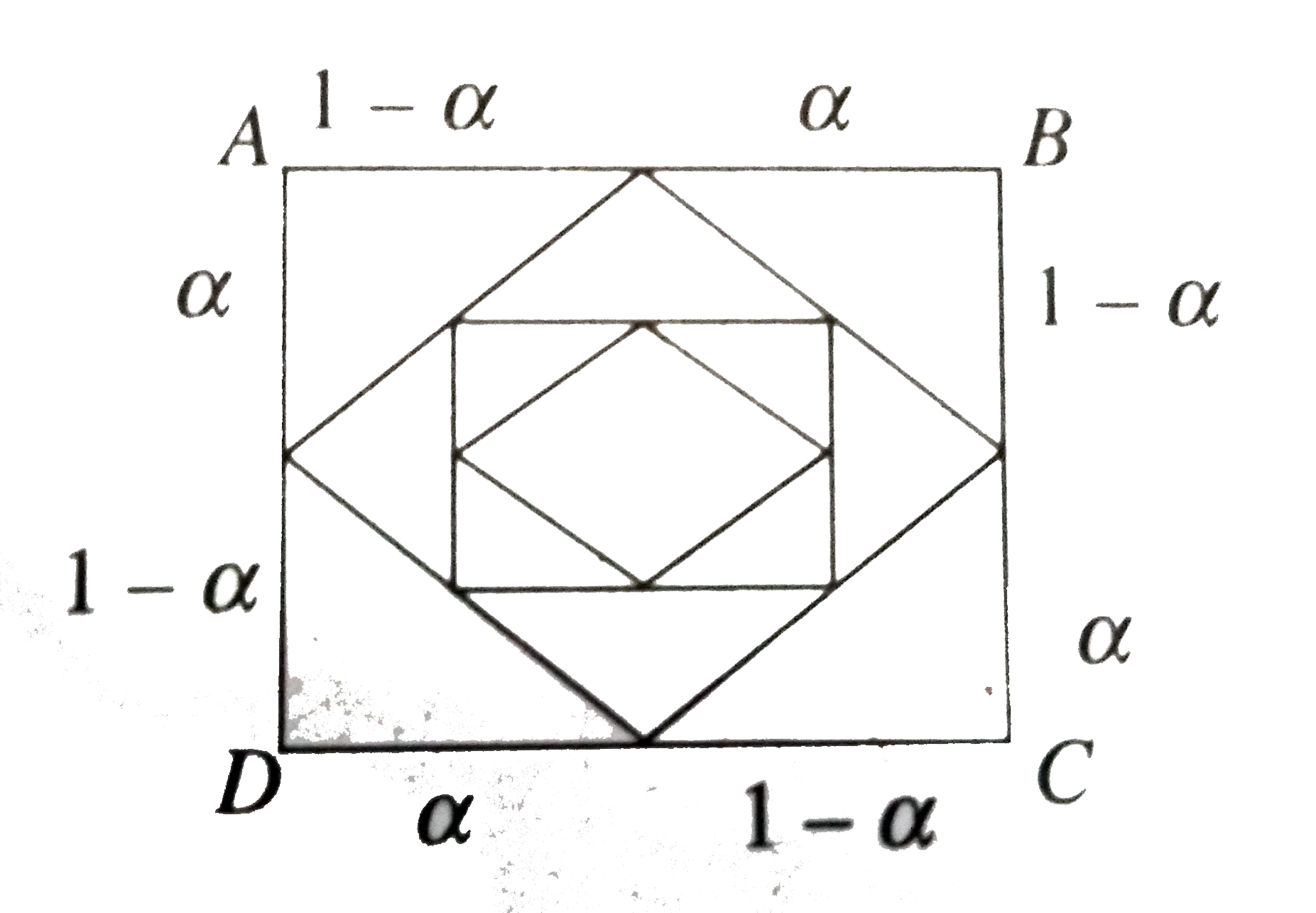Let A1,A2,A3,…..,An be squares such that for each n≥1 the length of a side of An equals the length of a diagonal of An+1. If the side of A1 be 20 units then the smallest value of 'n' for which area of An is less than 1.
7
8
9
10
The correct Answer is:D
To solve the problem, we need to find the smallest value of n such that the area of square An is less than 1, given that the side length of A1 is 20 units and the side length of An is defined in terms of the diagonal of the next square An+1.
1. Define the side lengths:
Let the side length of square An be denoted as an. We know that:
a1=20 units
2. Relationship between side lengths:
The diagonal d of a square with side length a is given by the formula:
d=a√2
According to the problem, the side length of square An is equal to the diagonal of square An+1:
an=an+1√2
3. Expressing side lengths recursively:
Rearranging the equation gives:
an+1=an√2
This means that each subsequent side length is 1√2 times the previous side length.
4. Finding a general formula:
Starting from a1=20:
a2=20√2=20⋅2−1/2=20⋅2−0.5
a3=a2√2=20⋅2−0.5√2=20⋅2−1=20⋅2−1
Continuing this pattern, we can generalize:
an=20⋅2−n−12
5. Calculating the area:
The area An of square An is given by:
An=a2n=(20⋅2−n−12)2=400⋅2−(n−1)
6. Setting up the inequality:
We need to find the smallest n such that:
An<1
This translates to:
400⋅2−(n−1)<1
Dividing both sides by 400 gives:
2−(n−1)<1400
7. Taking logarithms:
Taking logarithm base 2 on both sides:
−(n−1)<log2(1400)
This simplifies to:
n−1>−log2(400)
Thus:
n>1−log2(400)
8. Calculating log2(400):
We know 400=24⋅25=24⋅52:
log2(400)=log2(24)+log2(52)=4+2log2(5)
Using log2(5)≈2.32193:
log2(400)≈4+2⋅2.32193≈8.64386
9. Finding n:
Now, substituting back:
n>1−8.64386⟹n>−7.64386
Since n must be a positive integer, we check for values of n starting from 1 upwards.
10. Testing values:
- For n=10:
A10=400⋅2−9=400512≈0.78125<1
- For n=9:
A9=400⋅2−8=400256≈1.5625>1
Thus, the smallest value of n for which the area of An is less than 1 is:
10
Let the side length of square An be denoted as an. We know that:
a1=20 units
The diagonal d of a square with side length a is given by the formula:
d=a√2
According to the problem, the side length of square An is equal to the diagonal of square An+1:
an=an+1√2
Rearranging the equation gives:
an+1=an√2
This means that each subsequent side length is 1√2 times the previous side length.
Starting from a1=20:
a2=20√2=20⋅2−1/2=20⋅2−0.5
a3=a2√2=20⋅2−0.5√2=20⋅2−1=20⋅2−1
Continuing this pattern, we can generalize:
an=20⋅2−n−12
The area An of square An is given by:
An=a2n=(20⋅2−n−12)2=400⋅2−(n−1)
We need to find the smallest n such that:
An<1
This translates to:
400⋅2−(n−1)<1
Dividing both sides by 400 gives:
2−(n−1)<1400
Taking logarithm base 2 on both sides:
−(n−1)<log2(1400)
This simplifies to:
n−1>−log2(400)
Thus:
n>1−log2(400)
We know 400=24⋅25=24⋅52:
log2(400)=log2(24)+log2(52)=4+2log2(5)
Using log2(5)≈2.32193:
log2(400)≈4+2⋅2.32193≈8.64386
Now, substituting back:
n>1−8.64386⟹n>−7.64386
Since n must be a positive integer, we check for values of n starting from 1 upwards.
- For n=10:
A10=400⋅2−9=400512≈0.78125<1
- For n=9:
A9=400⋅2−8=400256≈1.5625>1
10
Topper's Solved these Questions
- SEQUENCE AND SERIES Book:VIKAS GUPTA (BLACK BOOK) ENGLISHChapter:SEQUENCE AND SERIES Exercise:EXERCISE (ONE OR MORE THAN ONE ANSWER IS/ARE CORRECT)
Explore 19 Videos
- SEQUENCE AND SERIES Book:VIKAS GUPTA (BLACK BOOK) ENGLISHChapter:SEQUENCE AND SERIES Exercise:EXERCISE (COMPREHENSION TYPE PROBLEMS)
Explore 16 Videos
- QUADRATIC EQUATIONS Book:VIKAS GUPTA (BLACK BOOK) ENGLISHChapter:QUADRATIC EQUATIONS Exercise:EXERCISE (SUBJECTIVE TYPE PROBLEMS)
Explore 45 Videos
- SOLUTION OF TRIANGLESBook:VIKAS GUPTA (BLACK BOOK) ENGLISHChapter:SOLUTION OF TRIANGLESExercise:Exercise-5 : Subjective Type Problems
Explore 11 Videos
Similar Questions
Knowledge Check
In the sequence an the nth term is defined as (an−1−1)2. If a3=64, then what is the value of a2 ?
A2B3C4D9
Let an=(1+1n)n. Then for each n∈N
View SolutionLet a1,a2,a3,……..,an be real numbers in arithmatic progression such that a1=15anda2 is an integer. Given 10∑r=1(ar)2=1185. If Sn=n∑r=1arand maximum value of n is N for which Sn≥S(n+1), then find N−10.
View SolutionIf A1,A2,A3 denote respectively the areas of an inscribed polygon of 2n sides , inscribed polygon of n sides and circumscribed poylgon of n sides ,then A1,A2,A3 are in
View SolutionLet a1,a2…,an be a non-negative real numbers such that a1+a2+…+an=m and let S=∑i<jaiaj, then
View Solution Let ABCD is a unit square and each side of the square is divided in the ratio α:(1−α)(0<α<1) . These points are connected to obtain another square. The sides of new square are divided in the ratio α:(1−α) and points are joined to obtain another square. The process is continued idefinitely. Let an denote the length of side and An the area of the nth square
Let ABCD is a unit square and each side of the square is divided in the ratio α:(1−α)(0<α<1) . These points are connected to obtain another square. The sides of new square are divided in the ratio α:(1−α) and points are joined to obtain another square. The process is continued idefinitely. Let an denote the length of side and An the area of the nth square
The value of α for which side of nth square equal to the diagonal of (n+1)th square is
View SolutionLet a1,a2,a3,... be a harmonic progression with a1=5anda20=25. The least positive integer n for which an<0, is
View SolutionLet A1,A2,A3,…,An be the vertices of an n-sided regular polygon such that 1A1A2=1A1A3+1A1A4. Find the value of n.
View Solution